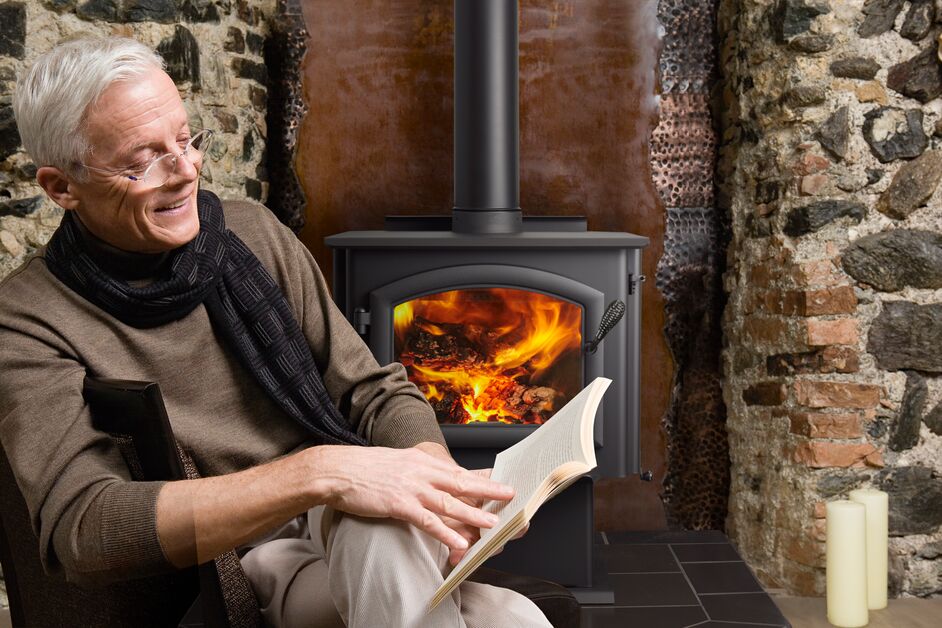You’ve enjoyed the cozy heat and crackling fire from your wood-burning stove for years. But you’ve recently started to notice it looks, smells, or burns differently. In this case, it might be time to consider a wood stove replacement.

With the proper care, the average lifespan of wood-burning stoves is 10 to 15 years, so it’s important to understand the warning signs your stove is aging and should be replaced. Read on as we detail these signs as well as how to replace a wood-burning stove.
Is Wood Stove Replacement Imminent?
To answer the question, “When should I replace my wood stove?” We looked to Clint Severens, fireplace installer at The Woodway Inc. He lives in Fairbanks, Alaska, where the average date of the season's first measurable snow is September 30, and the average winter temperature is -7.9°F. So, it’s safe to say he knows a few things about staying warm during numbing cold seasons!
Clint urges wood stove owners to follow routine spring cleaning, ongoing maintenance suggested in their owner’s guide, and hire a professional to inspect/sweep each year.
Through a thorough inspection and sweep, you can identify the following warning signs your wood stove is flatlining. (Spoiler: you may get a beautiful, brand new one!)
1. Steel warping:
“If the top of the stove starts to look like rolling ocean waves instead of a smooth, flat surface, that indicates the steel is compromised, probably not just on the top but throughout the unit,” Clint says. “Warping will allow more air to enter into the stove than it was engineered to contain, and that will reduce efficiency.” Warping also adds an unpleasant aesthetic to your stove.
2. Shortened burn times:
Clint also mentions that it’s a good idea to pay attention to burn times. “If the stove gets really hot, but burns out quickly, it could be because of a leak in a crucial area like the door, gasket seal, or ash pan,” he says. After a while, the stove will behave almost as if the door were open all the time. When this happens, it creates heat inefficiency, which means you may burn through more wood than you need.
3. Sluggish performance:
“You might be struggling to light the stove or find you’re smoking up the house when you’re lighting it,” Clint remarks. “That could mean the baffle has caved in, or other welded components have warped.”

In addition to his advice, here are some other warning signs it’s time to replace your wood-burning stove.
Why is a Wood Stove Replacement Necessary at Times
An aging stove is dangerous and produces an inefficient fire. In addition, older wood-burning stoves are not up to current EPA standards and don't burn as clean, which means they produce more smoke than they have to. Newer, EPA-certified stoves go through strict third-party testing and are evaluated and certified by the EPA. In fact, the newest models help to reduce tiny particle emission by 70%, which keeps your air clean and fresh!
While it’s never fun to have to replace a hard-working appliance, Clint does note that an upgrade can come with significant benefits: “You’ll notice an efficiency increase going from older technology to newer, updated, safety standards. And, depending on how old your previous model was, you might notice significant fuel savings, too.”
In addition, new stove owners could qualify for a special tax credit that furthers the savings. Effective January 1, 2023 through December 31, 2032, a new Federal Biomass Tax Credit is available for qualifying wood stove purchases. Taxpayers who install qualifying wood and pellet stoves can receive a 30% tax credit up to $2,000 annually, based on the full cost (purchase and installation) of the unit. To learn more about the tax credit and to explore Quadra-Fire's qualifying products, visit here.
How to Replace a Wood-Burning Stove
If you’re wondering how to replace a wood stove, you can do it one of two ways:
1. Do it yourself
2. Work with a certified installer
If you choose the first approach, know there are multiple steps involved and that it comes with risk. However, if you're confident you can do it safely, you can save money and take extra pride in your work. To get the right guidance for wood stove removal and installation refer to the installation and owners manual.
For safe and reliable installation, hire a professional installer recommended by a specialty hearth retailer and certified by the National Fireplace Institute®. They are trained specifically to install these types of products and will obtain the necessary permits and perform inspections for the stove and its vital components to ensure it burns safely for years to come.

Ready to Take the Next Steps?
If you read the advice above and found that it’s indeed the time to replace your wood stove, opt for a Quadra-Fire best-selling wood stove. With a range of choices like the eye-catching Discovery III wood stove and the timeless 2100 Millennium wood stove, there is a stove for any taste. Quadra-Fire stoves are known for maximum heating efficiency and a classic, appealing style. They can add the ideal amount of warmth, comfort and ambiance to your space.
Once you browse your options online, a certified Quadra-Fire dealer can hook you up with the right resources and products to swap out your old wood-burning stove with a new one so you can gather around a crackling fire with peace of mind.






